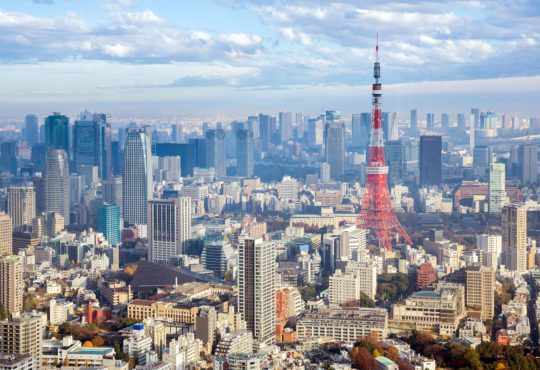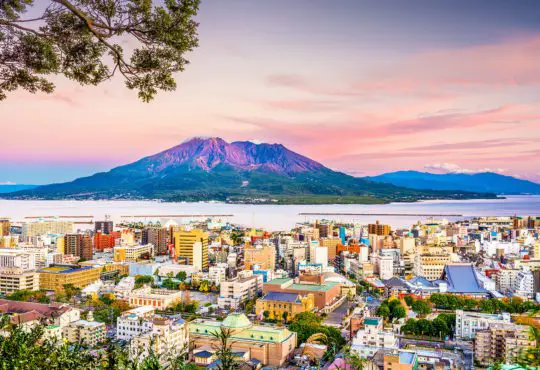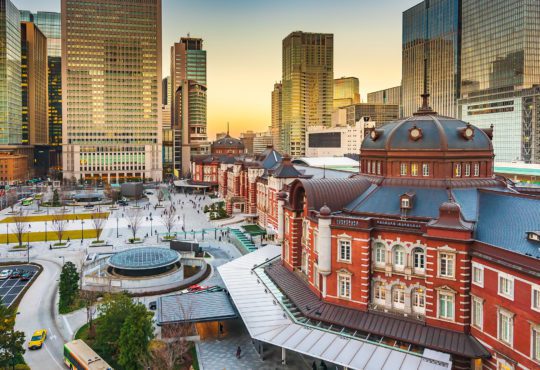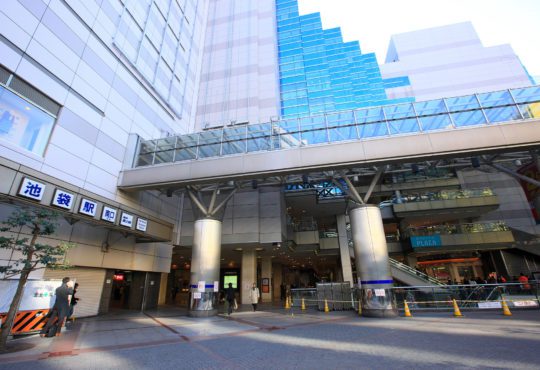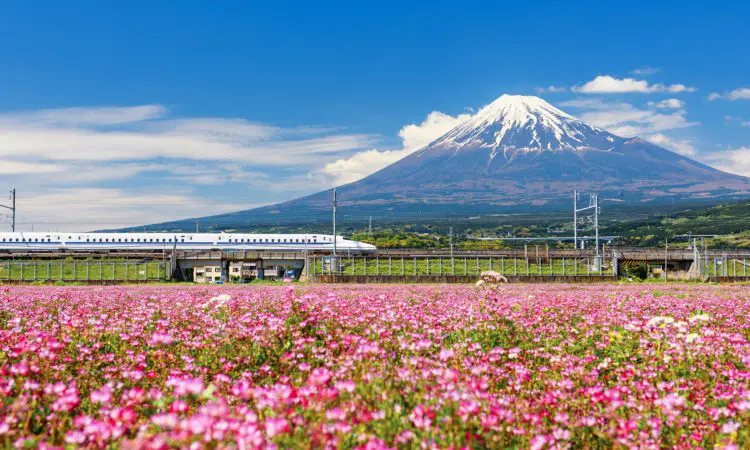
Japan is a land of extremes. High volcanic mountains, vibrant cities that never sleep and extreme weather and seismic activity are just a few of the features you might think of when conjuring images of Japan.
However, Japan also excels when it comes to transportation. The Shinkansen Bullet Train is a technological enigma that gets its citizens and holiday travelers, alike to their destinations faster and safer than traditional trains.
Contents
- 1 How fast does the Shinkansen go?
- 2 Why is the Shinkansen nose so long?
- 3 Is Shinkansen faster than a plane?
- 4 How many deaths have been caused by Shinkansen?
- 5 How much does Shinkansen cost?
- 6 How Can I Buy Shinkansen Tickets?
- 7 Can I sleep on Shinkansen?
- 8 Can you drink on Shinkansen?
- 9 Can you get on and off Shinkansen?
- 10 Does Shinkansen run 24 hours?
- 11 How comfortable is the Shinkansen?
- 12 What is the train etiquette for Shinkansen?
How fast does the Shinkansen go?
Shinkansen is a high speed train that can travel up to 200 miles her hour. Shinkansen Bullet Trains in Japan are among some of the fastest trains in the world. However, Maglev technology, which are trains that use magnetic levitation to reach speeds exceeding 300 miles per hour beat out Shinkansen when it comes to speed. This technology exists in one area in Japan, South Korea and China.
Why is the Shinkansen nose so long?
Shinkansen long nose creates aerodynamic effects that allow the train to reach such high speeds. The long nose also prevents sonic booms that might often happen in tunnels, creating undesirable outcomes.
Is Shinkansen faster than a plane?
Shinkansen is not faster than a plane. Shinkansen travels at speeds up to 200 mph, while an airplane can exceed 500 miles per hour. However, when you take the time involved in traveling to the airport, airport security, checking baggage and waiting for take-off, Shinkansen train travel may actually get you to your destination faster.
How many deaths have been caused by Shinkansen?
Since Shinkansen opened its first train line in 1964, there have been no deaths or injuries caused by derailments or malfunctions. This fact lends to the idea that Shinkansen is the safest train to ride in the world.
However, Japanese officials have recently began installing blue LED lighting in train stations to deter suicidal passengers from jumping in front of high speed trains. This has become a problem in Japan with the suicide rate by train being as high as 2,000 people per year.
How much does Shinkansen cost?
Shinkansen cost anywhere from 800 Yen ($6 USD) for shorter local trips to 11,000 Yen ($82 USD) for longer trips, plus the base fare, which depends on the distance you are traveling.
You will receive two tickets, the base tickets and the supplement ticket. Base fare tickets cost 20 Yen ($.15 USD) per kilometer for short distances and 10 Yen ($.07 USD) for longer distances. The longer the trip the cheaper the base fare per kilometer.
Shinkansen Supplement Fare, also known as the Limited Express Fee is 800 Yen ($6 USD) for shorter trip and 11,000 Yen ($82 USD) for longer distances.
If you choose to reserve a seat, you will be paying about 500 Yen ($4 USD) extra fare in addition to the above fees.
Sitting in “First Class”, will have you paying a Green Car Fee. This is in the range of 500 Yen ($4 USD) to 11,000 Yen ($82 USD) depending on how long your trip will take.
Night Trains also incur extra fees. You will pay an extra fee between 6,600 Yen ($50 USD) and 14,000 Yen ($100 USD). The fee you pay depends on the category of berth you choose. There is a range from economical to luxury and everything in between.
How Can I Buy Shinkansen Tickets?
You can purchase Shinkansen train tickets online before you arrive or you can buy tickets inside the train station at vending machine kiosks or from a ticketing representative.
Can I sleep on Shinkansen?
There are options for choosing a “sleeper” seat. There are areas on Shinkansen that have “nobi nobi” or an area where you can lie down. There is not a bed per se, but a dedicated, carpeted area with a partition for you and your things where you can stretch out and rest. There will be a window, a small table and some bedding and blankets for you to use.
There are also options to upgrade this experience and choose a cabin. The “A Cabins” feature a single bed, where the “B Cabins” provide twin beds.
You can also opt for a room on the Twilight Express Mikukaze, which will be the most luxurious accommodations available. Enjoy private cabins, spacious beds, warm wood interiors, decorated with the most modern art and private bathrooms. You will pay for all this opulence with a price from 380,000 Yen ($2,800 USD) to 750, 000 Yen ($5,500 USD). However, this will be an experience that will not soon be topped!
Can you drink on Shinkansen?
You can drink alcoholic beverages on Shinkansen. You may bring your own beverage onboard. Likewise, beer, sake and whiskey are also old on Shinkansen.
You can also eat and drink on Shinkansen. There is a seat with a table and cupholder. A vendor will make rounds selling snacks, bento boxes, sandwiches and drinks while on your journey. You can also bring food from outside the train.
Can you get on and off Shinkansen?
There are some spots where you can take a quick twenty minute ride on Shinkansen just to get the experience on a high speed bullet train. This will cost you about 1,000 Yen ($8 USD).
Does Shinkansen run 24 hours?
Shinkansen do not run 24 hours a day. Shinkansen generally run from 5a.m. to Midnight. However, ensure that you check your schedule for the exact times for your train line.
How comfortable is the Shinkansen?
Riding Shinkansen is a comfortable and enjoyable experience. The seats provide for spacious legroom with storage in the seat pocket in front of you. In addition, the seats recline and also have a tray table and cup holder for your food and beverages.
What is the train etiquette for Shinkansen?
There are certain things that you should and should not do on Shinkansen. Do not talk loudly, talk on your phone at your seat or crowd the walkway with your things. Read on for more Shinkansen Etiquette tips.
Do not eat food on a train unless it is a Shinkansen long distance trip. In fact, food and beverages will be sold on these trips, so it is perfectly acceptable to eat and drink at your leisure. Ensure that you dispose of all wrapper and trash as littering is severely frowned upon on trains.
Talking on the phone should be restricted to the designated phone use area. You can use your phone at your seat for streaming, but ensure you wear headphones as not to disturb the other passengers.
Your ride on the Shinkansen will be mostly silent. There is a reason for this, as it is considered rude to talk loudly on the train. Most passengers are silent with very minimal whispering conversation.
Smoking on Shinkansen s prohibited in general. There is a designated smoking car on some Shinkansen that will allow you to enjoy your choice of tobacco usage.
Priority seating is an area that is reserved for the elderly, those with physical limitations and women who are pregnant or with small children. If you choose this seat while it isn’t crowded, you may have to move if the traffic picks up in this area.
There may be times that you are riding Shinkansen when it is exceptionally busy. In this case, be aware of your belongings and ensure they are not taking up too much space. Use overhead spaces if available or check with an attendent about storing larger items.
Learn the phrase, “sumimasen” (pronounced soo-me-mah-sen), so that you can politely exit the train when it is time for you to disembark. Utterly “sumimasen”, will signal others to part so that you can gather your things and get off at your stop.
Traveling by Shinkansen is by far the quickest and most cost effective way to see Japan. With comfort, scenery and a place to rest your head, you are in for a great experience as you explore Japan.



